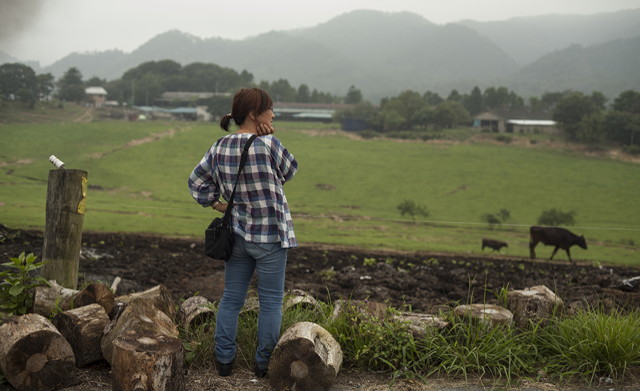By providing your information, you agree to our Terms of Use and our Privacy Policy. We use vendors that may also process your information to help provide our services. This site is protected by reCAPTCHA Enterprise and the Google Privacy Policy and Terms of Service apply.
It’s Not Film. It’s Not TV. It’s Convergence. Here’s What It’s All About

Paula Bernstein

 Whether you call it immersive storytelling, interactive filmmaking, transmedia or another term, what it all boils down to is new ways of connecting to audiences. Innovative, non-linear and new forms of storytelling will be on display at the upcoming New York Film Festival‘s Convergence, which kicks off on Saturday.
Whether you call it immersive storytelling, interactive filmmaking, transmedia or another term, what it all boils down to is new ways of connecting to audiences. Innovative, non-linear and new forms of storytelling will be on display at the upcoming New York Film Festival‘s Convergence, which kicks off on Saturday.
READ MORE: What’s to Be Gained with Immersive Storytelling?
As The Film Society of Lincoln Center explains on its schedule for The New York Film Festival’s Convergence program: “The advent of the digital age has created a new sort of audience. No longer content to be passive consumers of entertainment, the members of the ‘new audience’ expect to be active participants in their media. The traditional lines separating the arts are being blurred by innovative makers who are creating stories that span multiple platforms, remixing the original and the established to create a bold new form of art.”
Convergence is broken down into three categories: films, panels, and interactive presentations. Indiewire has informally surveyed some of the participants of this year’s Convergence to find out what the term means to them, and why now is the time to explore non-linear storytelling.  To kick off Convergence, Henry Jenkins, the Provost’s Professor of Communication Journalism and Cinematic Arts at USC’s Annenberg School for Communication and Journalism, will deliver the keynote address, “A Brief History of Transmedia Worlds,” which will track the progression of immersive story worlds.
To kick off Convergence, Henry Jenkins, the Provost’s Professor of Communication Journalism and Cinematic Arts at USC’s Annenberg School for Communication and Journalism, will deliver the keynote address, “A Brief History of Transmedia Worlds,” which will track the progression of immersive story worlds.
According to Jenkins, he will “provide a conceptual map for understanding what we mean by ‘worlds,’ what roles they are playing in the production and consumption of popular media, how thinking in terms of worlds involves a shift from more traditional focuses on character and narrative, and why this concept has gained such traction in an era of networked communication and transmedia entertainment.”
 Following are a selection of other projects which will be presented at Convergence, along with their creators’ thoughts on convergence and new forms of storytelling:
Following are a selection of other projects which will be presented at Convergence, along with their creators’ thoughts on convergence and new forms of storytelling:
“Last Hijack” (Tommy Pallotta, Femke Wolting, 2014):
Both a feature-length film, combining documentary footage and animation, as well as an online transmedia experience, “Last Hijack” (which previously screened at Berlin and SXSW) allows viewers to explore the story of Somali piracy from various perspectives.
“Convergence is where technology and storytelling collide. This is not a new idea, the art of movies has always had technology at its heart, but the exponential advances in the digital field has led to an acceleration of how we can use technology in storytelling that is unprecedented. It is an exciting time to explore and take chances in storytelling because there is open-mindedness when you step outside of traditional platforms and media. It is exciting because you can overreach and fail, but by pushing the boundaries you have success that has never been experienced before. At the end of the day, you can get interest for a novel way of telling the story, but the craft of storytelling is still at the heart of any compelling experience and is really the ‘killer app.'” — Tommy Pallotta and Femke Wolting
Artifacts of Fukishima: Selections from Unknown Spring (Jake Price, Visakh Menon, 2014):
“Artifacts of Fukishima” will present fragments of what was left behind nearly four years after an earthquake off the coast of Tohoku spawned a tsunami that destroyed swaths of the Japanese coast and initiated a nuclear disaster at the Fukushima Daiichi Nuclear Plant power plant. Combining projected video, audio and photography, “Artifacts” immerses viewers in the cityscapes of the abandoned towns, guided by the voices of those who fled their homes.
“At this point, immersive storytelling is in its infancy, not really regarded as an artform the way cinema is. By having events such as convergence and because NYFF is such a well established festival it lends credibility to these exciting new forms of storytelling, something that I know will continue to grow. The momentum is unstoppable. What’s going on in immersive storytelling is analogous to the truly independent American cinema of the 70s (or any of the other ‘New Waves’) where there was a lot of freedom and excitement to try new things. Art in general should always be searching for the new and undefined—immersive storytelling is providing that spark right now.” — Jake Price
We The Economy
Paul G. Allen’s Vulcan Productions and Morgan Spurlock’s Cinelan have partnered to produce the short film series “We The Economy,” to promote awareness of the vital role that people play in driving the economy. Featuring genre-crossing shorts by award-winning filmmakers (including Mary Harron, Catherine Hardwicke, Barbara Kopple, Bob Balaban, Marshall Curry and others), “We The Economy” is an online, mobile and offline experience.
“Convergence means the intersection of traditional media with viewer involvement. It’s taking a very passive viewing experience to the level of not only interactivity but to executable action…There are now more opportunities than ever before for storytellers- there are so many platforms and arenas where you can not only create but you can also view programming. I’m a real believer in being platform agnostic and finding the best home for whatever you’re creating.”– Morgan Spurlock
Loves of a Cyclops (Nathan Punwar, 2013)
“Loves of a Cylops” is a short film which follows the sprawling life story of Francis — a modern-day one-eyed man — as he struggles to see the world the same way as everyone else. Francis’s story extends beyond the film through a series of archival documents including artifacts, oddities and abandoned films. Through a guided tour from director/creator Nathan Punwar following the screening, the audience will experience these elements first-hand.
“For us, convergence means creating a complete world for our story by carrying individual elements out of the time constraints of the film that encompasses them. Every piece still ties back to the central heart of the main idea, but we’re pulling out all of these threads — the fabric used in the costumes, the artworks created by characters, the recordings behind the scenes — and giving them lives of their own so that audiences can feel fully enveloped in even the most absurd fiction. So ideally, convergence leads to an innate trust in the way the story tries to give order to this created world.” — Nathan Punwar
READ MORE: What’s The Future of Storytelling? ‘Unknown Spring’ Provides Some Answers
By providing your information, you agree to our Terms of Use and our Privacy Policy. We use vendors that may also process your information to help provide our services. This site is protected by reCAPTCHA Enterprise and the Google Privacy Policy and Terms of Service apply.

















